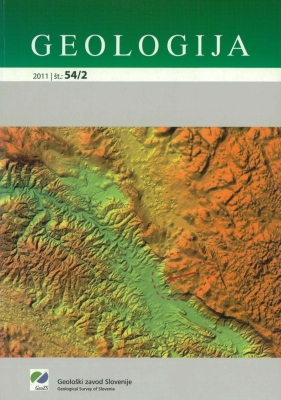Mineralogy and mineral chemistry of rare-metal pegmatites at Abu Rusheid granitic gneisses, South Eastern Desert, Egypt
DOI:
https://doi.org/10.5474/geologija.2011.016Abstract
The Abu Rushied area, situated in the South Eastern Desert of Egypt is a distinctive occurrence of economically important rare-metal mineralization where the host rocks are represented by granitic gneisses. Correspondingly, mineralogical and geochemical investigation of pegmatites pockets scattered within Abu Rusheid granitic gneisses revealed the presence of Hf-zircon, ferrocolumbite and uranyl silicate minerals (uranophane and kasolite). Electron microprobe analyses revealed the presence of Nb-Ta multioxide minerals (ishikawaite, uranopyrochlore, and fergusonite), uraninite, thorite and cassiterite as numerous inclusions in the recorded Hf-zircon and ferrocolumbite minerals. Abu Rusheid pegmatites are found as small and large bodies that occur as simple and complex (zoned) pegmatites. Abu Rusheid rare-metal pegmatites occur as steeply dipping bodies of variable size, ranging from 1 to 5 m in width and 10 to 50 m in length. The zoned pegmatites are composed of wall zone of coarser granitic gneisses, intermediated zone of K-feldspar and pocket of mica (muscovite and biotite), and core of quartz and pocket of mica with lenses of rare metals. The zircon is of bipyramidal to typical octahedral form and short prisms. Because the zircon of the investigated Abu Rushied pegmatite frequently contains hafnium in amounts ranging between 2.31 and 11.11%, the studied zircon was designated as Hf-rich zircon. This zircon commonly exhibits a normal zoning with rims consistently higher in Hf than cores. The bright areas in the crystal either in core or rim showed a remarkable enrichment in hafnium content (8.83-11.11%) with respect to the dark zones (3.19%). The investigated ferroclumbite commonly exhibits zoning; the dark zone is low in the Ta and U but the light zone is enriched in Ta (13%) and U (1%). EMPA analyses indicate the chemical composition of ishikawaite with U ranging from 0.68 to 0.79 per formula unit. Uranopyrochlore species has dominant uranium in the A-site where it ranges from 12.72 to 16.49% with an average of 14.84%. The calculated formula of the studied fergusonite is A(Y0.303 ΣREE0.014 U0.135 Th0.063 Ca0.013 Pb0.006 Si0.213 Zr0.035 Hf0048 Fe0.105)Σ0.935 B(Nb0.61 Ta0.084 Ti0.01)Σi0.704 O4. The presence of uraninite (high Th, and REE contents) and thorite, indicates that these minerals magmatic processes and followed by hydrothermal processes which are responsible for the precipitation of Nb-Ta multioxide minerals. Uranophane and kasolite of Abu Rusheid pegmatites are most probably originated from hydrothermal alterations of the primary uraninite. Abu Rushied pegmatites are characterized by being of ZNF-type due to their marked enrichement in Zr, Nb, and F, with a typical geochemical signature: Zr, Nb »Ta, LREE, Th, P, F. Accordingly, the mineralized Abu Rushied pegmatite can be considered as a promising target ore for its rare metal mineralization that includes mainly Nb, Ta, Y, U, and REE together with Zr, Hf, Sn and Th.Downloads
How to Cite
Raslan, M. F., & Ali, M. A. (2011). Mineralogy and mineral chemistry of rare-metal pegmatites at Abu Rusheid granitic gneisses, South Eastern Desert, Egypt. Geologija, 54(2), 205–222. https://doi.org/10.5474/geologija.2011.016
Issue
Section
Articles

